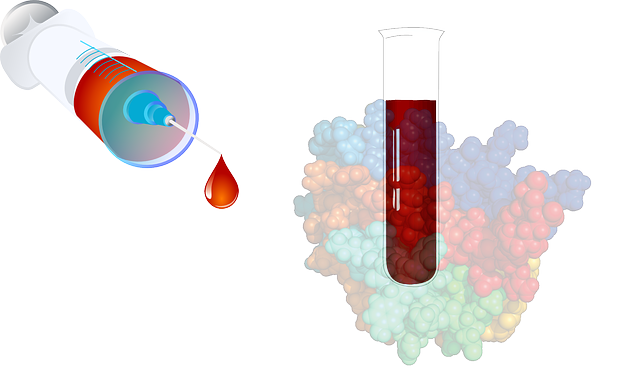Diabetes blood tests are crucial tools for predicting and preventing prediabetes and type 2 diabetes, measuring blood sugar levels with normal fasted levels ranging from 70 to 100 mg/dL. Prediabetes (100-125 mg/dL) is a warning sign requiring attention, with risk factors including sedentary lifestyle, obesity, family history, age over 45, unhealthy eating, and medical conditions. Early detection through regular diabetes blood tests is vital for preventing progression, enabling proactive health management and reducing the risk of severe diabetes complications. Lifestyle changes like balanced diets and exercise, along with medical interventions if needed, are effective in managing prediabetes, underscoring the significance of diabetes blood tests in monitoring progress and adjusting treatment plans.
“Uncover the power of a simple yet vital tool in diabetes prevention—the blood glucose test. This article guides you through the process, from understanding how it works to interpreting results. We explore prediabetes, its subtle signs, and risk factors, emphasizing the importance of early detection. Discover how regular blood sugar monitoring can avert severe complications and learn about effective lifestyle changes and medical strategies for managing prediabetes. Take control of your health with this essential diabetes blood test knowledge.”
- Understanding Blood Glucose Tests: How They Work and What to Expect
- Prediabetes: Recognizing the Warning Signs and Risk Factors
- The Role of Blood Sugar Monitoring in Preventing Diabetes Complications
- Lifestyle Changes and Medical Interventions for Managing Prediabetes
Understanding Blood Glucose Tests: How They Work and What to Expect
Blood glucose tests, also known as diabetes blood tests, are a crucial tool for predicting and preventing prediabetes and type 2 diabetes. These tests measure the amount of glucose (a type of sugar) in your blood. Glucose is essential for energy production, but high levels can indicate insulin resistance or impaired glucose tolerance, which are hallmarks of prediabetes.
During a typical diabetes blood test, a healthcare provider will take a small sample of your blood, usually from a finger prick or a vein. The sample is then analyzed to determine your blood sugar level. Normal blood glucose levels fast (after fasting for at least eight hours) typically range between 70 and 100 mg/dL (milligrams per deciliter). Prediabetes is indicated by slightly higher levels, usually between 100 and 125 mg/dL. Continuous monitoring and lifestyle changes, such as diet adjustments and increased physical activity, can help prevent or delay the progression to type 2 diabetes.
Prediabetes: Recognizing the Warning Signs and Risk Factors
Prediabetes is a crucial warning sign, indicating that an individual’s blood glucose levels are higher than normal but not yet high enough to be diagnosed as type 2 diabetes. Recognizing this state is essential for effective prevention and management. A simple diabetes blood test can uncover these hidden risks, providing valuable insights into an individual’s metabolic health.
Several risk factors contribute to the development of prediabetes, including a sedentary lifestyle, obesity, especially around the waist, a family history of diabetes, and age (those over 45 are at a higher risk). Unhealthy eating habits and certain medical conditions, such as high blood pressure or abnormal cholesterol levels, also play a significant role. Early detection through regular diabetes blood tests is vital to prevent prediabetes from progressing to type 2 diabetes, emphasizing the importance of proactive health management.
The Role of Blood Sugar Monitoring in Preventing Diabetes Complications
Blood sugar monitoring is a powerful tool in the prevention and management of prediabetes, playing a pivotal role in mitigating potential diabetes-related complications. Regularly checking blood glucose levels allows individuals to gain valuable insights into their metabolic health. This proactive approach enables early detection of abnormalities, which is crucial as it gives people a head start in making lifestyle changes or seeking medical intervention.
By keeping a close eye on blood sugar, individuals can take measures to prevent diabetes from progressing. It encourages adopting healthier habits like balanced dieting and regular exercise, proven methods to stabilize blood glucose. Moreover, awareness of one’s numbers facilitates timely discussions with healthcare professionals who can offer personalized guidance and treatment plans, ultimately reducing the risk of severe diabetes complications such as nerve damage, kidney issues, or cardiovascular disease.
Lifestyle Changes and Medical Interventions for Managing Prediabetes
Prediabetes is a critical stage where individuals are at risk of developing type 2 diabetes, and early intervention can make a significant difference. Lifestyle changes play a pivotal role in managing prediabetes effectively. Adopting a balanced diet with whole grains, fruits, vegetables, and lean proteins can help regulate blood glucose levels. Reducing the intake of processed foods, sugary beverages, and saturated fats is essential as these can contribute to weight gain, a key factor in diabetes development. Regular physical activity is another powerful tool; aiming for at least 150 minutes of moderate-intensity exercise weekly can improve insulin sensitivity and lower blood sugar. Additionally, maintaining a healthy weight through diet and exercise combinations can prevent the progression to type 2 diabetes.
While lifestyle modifications are the foundation, certain medical interventions can also assist in managing prediabetes. Some medications, like metformin, have been shown to reduce the risk of developing diabetes by improving insulin production and sensitivity. Other drugs may be prescribed to control blood sugar levels, but these are typically considered for those with more significant risks or existing comorbidities. Regular monitoring through diabetes blood tests is crucial for gauging progress and making necessary adjustments to treatment plans.
A diabetes blood test, such as the HbA1c test, is a powerful tool in predicting and preventing prediabetes from progressing to type 2 diabetes. By understanding the results of these tests and taking proactive measures, individuals can significantly reduce their risk of developing diabetes-related complications. Lifestyle modifications, including dietary adjustments and increased physical activity, play a pivotal role in managing prediabetes. Additionally, medical interventions like medication or insulin therapy can help those at high risk maintain healthy blood sugar levels. Early detection through regular blood glucose testing is key to implementing these strategies and fostering long-term diabetes prevention.
